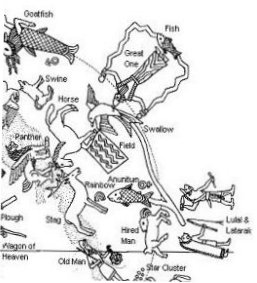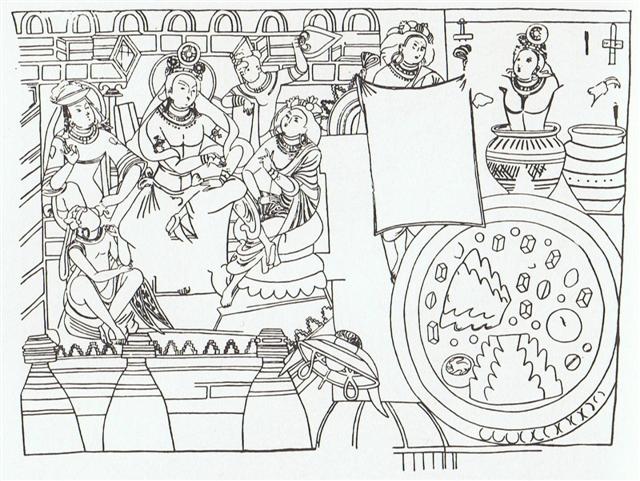3. Moving from lower to higher right ascension the beginning of the river evidently is close to the south pole and its end at the left foot of Orion. Although Achernar was outside the view of the classical world it was well known by people living further south. It certainly was known by the Polynesians: "Pua, Flower, is a bright Tuamotuan star identified as Achernar by Fariua, although Kamake and Teofiro declared it to be in the northern sky. There is independent evidence that Fariua was correct, for a line from a chant translated by Stimson: 'The Pleiades and the great star Pua traverse, one the northern sky, one the southern', points directly to Achernar as a brilliant star in the south on nearly the same hour circle as the Pleiades." (Maud Worcester Makemson, The Morning Star Rises. An Account of Polynesian Astronomy.) The Pleiades was once a universal sign for the beginning of the new year and presumably, therefore, Achernar had a similar meaning. Its position far south (down in the 'water') and its white colour suggests it could refer to the beginning of a great Moon cycle. And when it nowadays is rising heliacally 24 days (96 right ascension minutes) after autumn equinox south of the equator it can announce the arrival of Moon as a ruler after Sun has left. But the Pleiades are not 'nearly on the same hour circle'. Its brightest star is Alcyone (η Tauri) at 03h 45m, and 225 - 96 = 129 minutes of right ascension in difference means 32╝ days. If Achernar is imagined as the source of a 'year', then Eridanus could be regarded as the river which brings the new ruler in form of Orion. This could have been a truth a long time ago, when Orion rose earlier than today. Later, a pair of navel strings maybe could have been imagined to emerge from Alrisha, although these strings are going from higher to lower right ascension, and instead of a single giant on 'land' the offspring evidently was regarded as a fish and a swallow:
The opposite direction of the strings suggests the river Eridanus is the Moon equivalent of the Sun 'bands'. And because Sun arrives from the far northern region of the sky Moon should be expected to rise like a great bubble from the watery region down in the south. Puapua = summit etc, and therefore pua should be its opposite, viz. the bottom of a valley etc:
Puapua also means 'a piece of cloth' and then its opposite (pua) should be 'uncovered' ('reborn'). The parallel with mauga followed by koti is obvious:
The blanket held out beyond what probably represents midsummer is at the summit (puapua):
|

